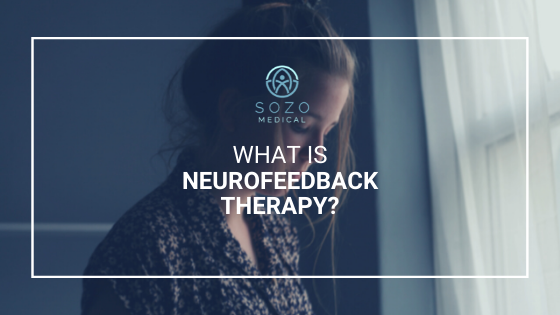Article Contents
Many individuals across America suffer from various forms of neurological conditions that require professional treatment. Whether it be depression, a mood disorder, or substance use disorder, approximately one in six individuals suffer from a neurological condition. While normal brain functioning is something most people can attest to, many individuals also suffer from brain imbalances or chronic negative emotions.
Fortunately, neurofeedback therapy has become recognized as an effective solution for mitigating neurological and psychological issues. To explain, neurofeedback therapy or EEG biofeedback is a treatment utilized to improve focus and control impulses for other brain functions. For example, neurofeedback is effective in treating issues such as ADHD and PTSD. Continue reading to learn more about what neurofeedback is, how it works, and how it is beneficial.
What is Neurofeedback Therapy?
To put it simply, neurofeedback therapy is a method utilized to train one’s brain. The brain is responsible for an individual’s thoughts, emotions, and movements. Neurofeedback is a form of Neurotherapy that involves placing sensors on the scalp of a patient to measure and monitor brain activity.
“Neurofeedback is the process of treating areas of the brain that display as imbalanced or compromised. For example, neurofeedback helps doctors identify an array of issues like ADHD, sleep, anxiety, and learning challenges.”
Sensors placed on the individual’s scalp analyze the brain to provide an accurate analysis of brain activity. Next, this software allows medical professionals to identify problem areas of the brain stemming from a neurological issue. As a result, experts are able to “rewire” the brain to correct any possible issues. This is done through the use of advanced computer technology that balances and optimizes your brain.
Neurofeedback is unlike any other form of treatment, as it is drugless, non-intrusive, and effective. This form of therapy is highly effective in balancing chemical issues in the brain, therefore, allowing patients to recover from neurological and psychological conditions. Additionally, neurofeedback is beneficial for children, as they find this treatment fun, engaging, interactive, and painless. Individuals receiving neurofeedback typically only require a few sessions.
How Does Neurofeedback Work?
There are three main components of neurofeedback: the EEG machine, brain analysis software, and the patient. The human brain consists mainly of a clump of brain cells that communicate via electrical signals. During neurofeedback, the sensors placed on the patient’s scalp work to detect these electrical impulses.
An Individual’s brain creates four types of electrical impulses during typical, daily activities. These brainwaves are referred to as alpha, beta, delta, and theta signals. By identifying these brainwaves, experts know which part of the brain is active and being utilized during specific activities.
Next, specialized software generates a QEEG map, displaying all of the “trouble spots” or chemical imbalances in the brain. Medical professionals will take note of the areas of concern before the patient moves onto the next phase of neurofeedback treatment. During the next phase of neurofeedback therapy, the brain will be trained to achieve states of relaxation or comfortability.
This phase of neurofeedback therapy will continue until the brain has adapted. To explain, an excellent way to think of neurofeedback is how a bodybuilder trains his muscles. Over time, bodybuilders train their muscles in order to lift weights with ease. Just as the bodybuilder trains to become stronger, the more sessions of neurofeedback a patient attends, the more likely the brain can enter a relaxed state.
In addition, the ability of the brain to adapt to these changes is defined as neuroplasticity. Because of neurofeedback, patients are able to change the way their brain behaves. For example, rather than acting impulsively when angry, the brain can enter an efficient and relaxed state.
The Benefits of Neurofeedback Therapy
After completing neurofeedback therapy, many patients receive heightened memory and focus as well as improved mental clarity. Additionally, a patient’s mood will improve, their anxiety will lessen, and they will be able to sleep more effectively. The benefits of neurofeedback therapy include the following.
Increased Memory
Many credible studies have shown a link between neurofeedback therapy and an improvement in memory. This may be a result of brain neuroplasticity. To explain, greater neuroplasticity is linked with significant synaptic action of the hippocampus. The hippocampus is the part of the brain responsible for short term memory. Short term memory includes remembering dates, conversations, and even directions to a location. Neurofeedback has been proven to improve an individual’s short term memory after completing frequent therapy sessions.
Decreased Anxiety
Individuals suffering from anxiety benefit immensely from neurofeedback treatment. Anxiety includes issues such as racing thoughts and restlessness of the mind. During neurofeedback, the QEEG map shows an increase in beta signals and a deficit of alpha signals when one is anxious.
To explain, anxiety stems from an overwhelming influx of beta waves. Neurofeedback tries to make the brain produce more alpha impulses. These alpha impulses keep you calm and help you maintain focus whenever you’re anxious.
Improved Sleeping Habits
Reduced sleep and insomnia are related to malfunctioning in brain impulses. Insomnia and decreased sleep are a result of slow-moving or irregular delta waves. Fortunately, neurofeedback corrects these issues by providing patients with enough fast-moving delta waves at night. As a result, patients will receive better sleep at night.
Improved Symptoms of Depression
Some studies have linked depression to slow-moving and irregular delta waves in the brain. This may explain why individuals with depression suffer from irregular sleeping patterns. Fortunately, neurofeedback could decrease depression symptoms and improve sleep. Therefore, if you suffer from symptoms of depression, neurofeedback may be beneficial for you.
Reduced Symptoms of ADHD
During neurofeedback, experts can identify ADHD on the QEEG map as slow-moving theta signals. Also, some patients may display a motor-sensory rhythm incapacity. Fortunately, neurofeedback helps to reduce symptoms of ADHD.
Overall Improved Brain Health
Having a big brain indicates that your brain is healthy, meaning greater cognitive abilities. Neurofeedback increases the quantity of white and grey matter in your brain. As a result, patients will receive a bigger and healthier brain.
Neurofeedback Therapy at Sozo Medical Group
Recovering from a mental illness or an addiction can seem like a daunting task. However, with the help of medical professionals and evidence-based treatment methodology, recovery is possible. Many substance abuse rehabs and mental health treatment centers have begun to include neurofeedback in their treatment approaches. If you or a loved one are suffering from symptoms of mental illness or addiction, neurofeedback can help regulate your symptoms and allow you to begin recovery. If you or a loved one is in need of neurofeedback for an addiction or mental health condition, contact our medical providers in Fort Lauderdale today.

All of the information on this page has been reviewed and verified by a certified addiction professional.

